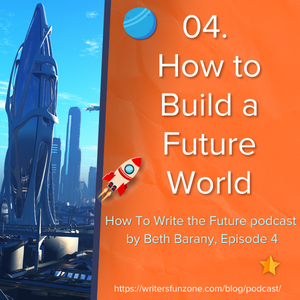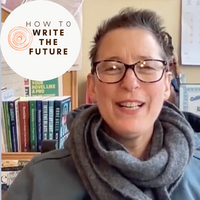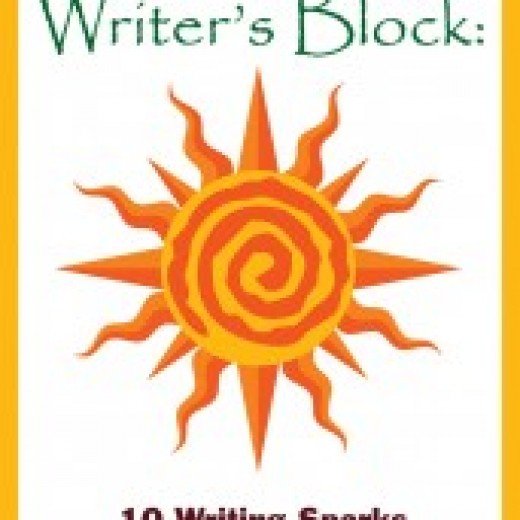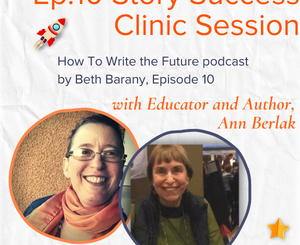How to Build a Future World: Tips for Writers

In today’s latest episode of “How To Write The Future” titled “How to Build a Future World” I share how I build my science fiction world in my Janey McCallister mystery series.
Have a listen to the latest episode on Apple Podcasts | Google Podcasts | Spotify | Buzzsprout | Amazon Music | Podcast Addict | Podchaser| Youtube
ABOUT BETH BARANY
 Beth Barany is an award-winning novelist, master neurolinguistic programming practitioner, and certified creativity coach for writers, including being a Workshop leader & keynote speaker. Beth has published books in several genres including young adult fantasy, paranormal romance and science fiction.
Beth Barany is an award-winning novelist, master neurolinguistic programming practitioner, and certified creativity coach for writers, including being a Workshop leader & keynote speaker. Beth has published books in several genres including young adult fantasy, paranormal romance and science fiction.
Learn more about Beth Barany at these sites:
Author site / Coaching site / School of Fiction / Writer’s Fun Zone blog
RESOURCES
Elizabeth Moon: http://www.elizabethmoon.com
Hitchhiker’s Guide to The Galaxy (original radio play): https://en.wikipedia.org/wiki/The_Hitchhiker%27s_Guide_to_the_Galaxy_(radio_series)
Ruby, the Galactic Gumshoe original radio play: https://www.zbs.org/index_new.php/store/ruby
Janey McCallister mystery series: https://author.bethbarany.com/e-books/
Talk to a Writing coach: https://writersfunzone.com/blog/talk-to-a-writing-coach/
SHOW NOTES
Do you want to learn how to build an immersive and believable world for your science fiction novel series?
In this episode you will learn:
- How Beth Barany builds her science fiction world in her Janey McCallister mystery series
- What inspirations Beth draws from when creating her stories
- The process she uses to filter her decisions about the worlds she creates and how you can use that process too
Do you want to learn how to build an immersive and believable world for your science fiction novel series?
“The point of sharing my story with you is to help you make decisions and clarify what is your world that you’re building for your story.”
I love listening to Hitchhiker’s Guide to the Galaxy on the radio. I also loved listening to Ruby the Galactic Gumshoe. These are some of my early influences. In this episode, I’m going to share a little bit about how I build my science fiction world in my Janey McCallister mystery series. The series is set 100 years plus in the future. I share a little bit about my process and method because you may find yourself at the beginning of a project or maybe in the editing phase.
In this episode, you will learn the following:
- How Beth Barany builds her science fiction world in her Janey McAllister mystery series
- What inspirations Barany draws from when creating her stories
- The process Barany uses to filter her decisions about the world she is creating.
TRANSCRIPT FOR 04. How To Build A Future World
When I was a kid in the seventies I loved listening to Hitchhiker’s Guide to the Galaxy on the radio.
Hi everyone. I’m Beth Barany. I am running a podcast here, How To Write The Future for science fiction writers who want to write positive futures and inject their visions into the marketplace.
I also loved listening to Ruby, the Galactic Gumshoe. That second one is much less well-known obviously. But some of my early influences came through listening to these amazing stories set in these fantastical future kind of worlds.
Hitchhiker’s Guide to the Galaxy was more absurd and funny, but still took us on this amazing galactic journey. Ruby, the Galactic Gumshoe was about a woman, an Android, I pretty sure, solving mysteries and encountering all kinds of creatures.
These are some of my early influences.
In this episode, I’m going to share a little bit about how I build my science fiction world in my Janey McCallister mystery series.
The series is set a hundred years plus in the future. It starts in 2130.
I want to share a little bit about my process and method, because you may find yourself as a science fiction writer in the beginning of a project or maybe in the editing phase of a project where you’re having to make decisions.
Creativity, writing novels, it’s all about making decisions.
So how do I go about making some of my decisions and what are some of my process?
And the point of sharing my story with you is to help you make decisions and clarify what is your world that you’re building for your story?
The first thing I want to talk about is when do I do this world building?
And what tools do I use, and what are some of my inspirations?
I start with world-building in the early stages. I spend time in a planning phase. And then there’s going to be the first drafting phase where I’m usually not world-building through planning things. It’s whatever is ready to come out into the story. And then in the editing phase, I refine a lot of the choices that I’ve already made and make new choices.
The first thing I noticed, and I shared with you in my introduction, is I’m pulling from inspiration.
If any point in the process I’m stuck, I go back to my inspirations, and my inspirations are everywhere. Anywhere from watching Star Trek TV series or movies to reading other people’s science fiction — I especially love Elizabeth Moon — to reading the latest science, technologies coming out of laboratories.
I really allow my curiosity to drive me. I’m also deeply curious about ancient human past and the ancient past of the planet. I’m very curious about the formation of stars and solar systems, and the latest launches by SpaceX and NASA and European Space Agency, and all the other space agencies on the planet.
I’m also feeding my curiosity by looking at a lot of images of the Earth from space as well as distant galaxies. I’m super fascinated by the images, the Webb, the James Webb space telescope has been revealing to us as well as the other space telescopes that have been in operation all these years.
From inspiration, I start asking What If.
What if the next space station that my main character Janey McCallister visits has a different society and economic model? I’ve been playing with a few different ideas and pretty soon I’ll be drafting some notes on those ideas.
The main point about building a future world is I try to filter as many of the decisions as I can about what this world will look like through my character’s point of view. Meaning people are going to read this story entirely from her point of view, from Janey’s point of view. They will know what she knows.
My first job is to write like a Q and A, interviewing my character about what is it that she knows about this new location.
My intent is that every book going forward in the series will be set on a new space station. The first four books were set on just one location, one space station that I got to explore deeply — this really high end hotel casino. Everything we learned about that location was through Janey’s knowledge and experience at that place.
So I want to do the same for the next location for the next book.
I may bring in another character’s point of view, in which case I will interview that character about what it is that they know. Now in my future world, people can have access to all kinds of information very easily, just like today. Of course my character will have done her homework and she will know what’s publicly available to know about that new location.
Some of the things I think about though, before I get deeply in to my character’s perspective is I think about the limitations of the world. What can people and technology not do in this world?
It might be a technology limitation, but it could also be a cultural limitation, which brings me to the norms.
What are the norms of technology and culture and politics?
What things are available? What kind of food is available? What kind of food isn’t available?
One of the things I have made is that coffee is very expensive in my world. Because my future world, I made the decision to have it be after sea levels have risen quite a lot. A lot of the coffee growing regions have been impacted. So there’s fewer coffee growing regions, and it’s very expensive to grow the coffee beans that makes coffee. People drink a lot of coffee derivatives and very good coffee is very expensive.
I allow my curiosity to drive me forward, but I’m also looking at today’s environment, today’s trends, and I’m asking the question: what if.
What if the sea levels rise? What impact is that going to have?
In my story, there are many, many people who’ve had to move. Locations have adapted and have created many floating cities. There are also many space stations in my story. I haven’t ever enumerated exactly how many. I will at some point. It’s not that important right now.
That brings me to another point, which is what is absolutely important to know for this next book.
Since this is book five that I’m building right now, I already know a lot about my world, but I don’t know everything. But I have made some decisions. I know where my main character is traveling to, what is critical for her to be able to go there and do her job.
The first thing I do is ask that question. Questions are so important. They allow our mind to start reaching for the answer.
Your turn.
What are the things you absolutely need to know to be able to write your story?
And what are the things that you’re curious about?
And the other thing that I have developed on my list here of how I world build as I start to daydream about sensory details about this world.
What does it smell like?
Is there a dominant sound in the location?
Is there a certain taste that go along with that location, like only certain kinds of foods are available and not others?
Is there a feeling of the air on her skin — my main character’s skin — that is different here than it is in other locations?
And what does it feel to walk around in the space station? Is the gravity different?
In my future world, I made the decision that artificial gravity was a normal thing. I didn’t explain it. This is very common in a lot of stories. It’s just there. I did spend some time thinking about how it could be generated, but I didn’t actually put it into the story. There is a scientific basis and I have thoughts that live in my backstory material. But is it necessary to the plot? Not necessarily. Maybe. I will think about this and I will brainstorm on this.
These are just some of the things that I do as I look into this next story, some of the questions I ask.
What are the questions for you to ask about the story world that you are building?
And tell me. Let me know how this sparked you.
What questions do you have? What are you still curious about?
Contact me through Twitter or LinkedIn @BethBarany. Email me directly if you’d like: beth@bethbarany.com.
When I work with my clients around world-building I usually start asking them questions.
What are you curious about? What do you want to know more of? And there’s another element, which is how did things come to be this way? Every time and place has a history, usually a pretty long history.
Since I’m creating a world in which there are space stations — who built them? Why did they build them? Why did they build it here?
If you’re writing a story set in the future, it’s been designed the way it is, right? It’s been built generally the way it is. Think about that.
When I’m working with my clients around their world building, I often ask questions that are around the logic of the world they’re building and sometimes something sounds illogical to me that leads them to explore their world deeper.
So if you need accountability, if you need support, if you need a guide, I am a creativity coach for writers and I work with writers to deepen their creative process, gain trust and confidence, so that they can work on their stories with ease.
If you’re curious about that, reach out to me. Talk to me. Discover if we’re a good fit. I’ve left a link in the show notes on how you can do that.
Let me know how your world-building is going. I would love to hear. Until next time.
Write long and prosper.
Connect with me
Email: beth@bethbarany.com
Loved this episode? Leave us a review and rating here: https://www.buzzsprout.com/2012061
or in your podcast home of choice.
***
CREDITS
EDITED WITH DESCRIPT
https://www.descript.com?lmref=_w1WCA (referral code)
MUSIC CREDITS
Music from Uppbeat (free for Creators!): https://uppbeat.io/t/soundroll/fuzz-buzz
License code: UMMKDRL02DFGKJ0L. “Fuzz buzz” by Soundroll.
Commercial license: https://musicvine.com/track/soundroll/fuzz-buzz
Distributed by Buzzsprout: https://www.buzzsprout.com/?referrer_id=1994465 (referral code)
SHOW PRODUCTION BY Beth Barany
SHOW NOTES SUPPORT from Kerry-Ann McDade
***
For more “How To Write the Future” episodes, go here.
If you’d like to invite Beth onto your podcast, drop her a note here.



